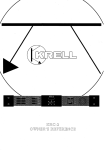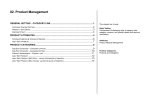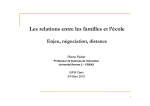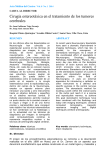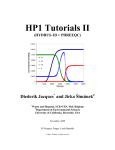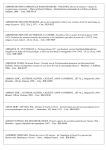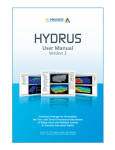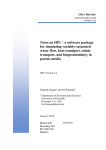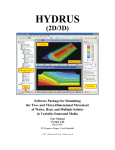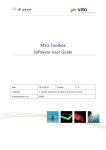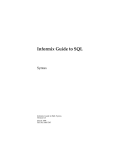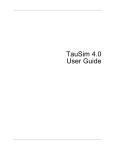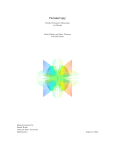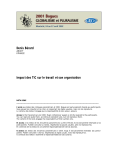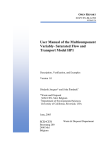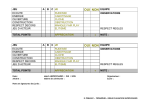Download External report - SCK-CEN
Transcript
EXTERNAL REPORT SCK•CEN-ER-140 10/SSc/P-60 GENAPAC A genetic algorithm for parameter calibration User’s manual Version 1.0 Sébastien Schneider September, 2010 SCK•CEN Boeretang 200 BE-2400 Mol Belgium PAS EXTERNAL REPORT OF THE BELGIAN NUCLEAR RESEARCH CENTRE SCK•CEN-ER-140 10/SSc/P-60 GENAPAC A genetic algorithm for parameter calibration User’s manual Version 1.0 Sébastien Schneider September, 2010 Status: Unclassified ISSN 1782-2335 SCK•CEN Boeretang 200 BE-2400 Mol Belgium © SCK•CEN Studiecentrum voor Kernenergie Centre d’étude de l’énergie Nucléaire Boeretang 200 BE-2400 Mol Belgium Phone +32 14 33 21 11 Fax +32 14 31 50 21 http://www.sckcen.be Contact: Knowledge Centre [email protected] RESTRICTED All property rights and copyright are reserved. Any communication or reproduction of this document, and any communication or use of its content without explicit authorization is prohibited. Any infringement to this rule is illegal and entitles to claim damages from the infringer, without prejudice to any other right in case of granting a patent or registration in the field of intellectual property. SCK•CEN, Studiecentrum voor Kernenergie/Centre d'Etude de l'Energie Nucléaire Stichting van Openbaar Nut – Fondation d'Utilité Publique - Foundation of Public Utility Registered Office: Avenue Herrmann Debroux 40 – BE-1160 BRUSSEL Operational Office: Boeretang 200 – BE-2400 MOL 5 Contents 1 Introduction .............................................................................................. 7 2 Description of the computer code ............................................................ 8 2.1 2.2 2.3 2.4 3 4 Features of GENAPAC......................................................................................... 8 Source code .......................................................................................................... 8 Resource files ....................................................................................................... 9 Output files ......................................................................................................... 10 Providing source code and resource files ............................................... 11 Examples ................................................................................................ 26 4.1 Calibration of unsaturated hydraulic parameters of concrete........................... 26 4.2 Calibration of unsaturated hydraulic parameters for a heterogeneous soil profile28 5 6 7 Conclusion .............................................................................................. 32 Acknowledgement .................................................................................. 32 References .............................................................................................. 32 6 The GENAPAC computer code is a genetic algorithm for parameter calibration. The code is written in FORTRAN 95. This user’s manual describes the source code and provides information to facilitate its use. This document contains an introduction (Chapter 1) which gives an overview of the general functioning of genetic algorithms. Chapter 2 provides explanations about the main program and the subroutines, whereas the Chapter 3 provides the source code. Two examples are given to demonstrate the versatility of the code in determining parameter estimates for complex problems (Chapter 4). The GENAPAC code can be coupled with any computer code such as those that solve the water flow and contaminant transport equations in soils and aquifers. For both of the two examples the HYDRUS-1D code (Šimůnek et al., 2009) for variably saturated water flow was used. 7 1 Introduction Heuristic search algorithms are efficient techniques for solving complex optimization problems. One of such algorithms is the genetic algorithm (GA). General literature on genetic algorithms is available from Goldberg (1989), or Goldberg and Deb (1991), amongst others. Genetic Algorithms (GAs) are stochastic search procedures widely used in many sciences for complex non-linear optimization problems (Zhang et al., 2009; Ines and Mohanty, 2008). GAs are a particular class of evolutionary algorithms that use techniques inspired by evolutionary biology such as inheritance, selection, crossover and mutation. To identify the optimal in a specified search space, GAs are implemented in a computer algorithm by a population of abstract representations (called chromosomes) of candidate solutions (called individuals) which evolve gradually towards an optimal solution of the optimization problem. Solutions could be represented in binary form as strings of 0s and 1s, but for many applications in soil hydrology, a representation with real-parameter values is much more convenient. The evolutionary process starts from a population of randomly generated individuals and proceeds through successive generations (see the general flowchart in Figure 1). In each generation, the fitness of every individual in the population is evaluated, multiple individuals are selected from the current population (based on their fitness, i.e. objective criterion), and modified (recombined and possibly randomly mutated) to form a new population. This loop is repeated in an iterative process, until the algorithm terminates when either a maximum number of generations has been produced or when some predefined performance criterion has been met. Figure 1. Flowchart of the principle of the genetic algorithm. 8 2 Description of the computer code 2.1 Features of GENAPAC GENAPAC is a genetic algorithm which has the following features: a) Real-parameters-coded. b) Selection operator: Roulette wheel selection. The selection process is a key step in the GA that embodies the idea of “fittest survival” in nature. A fitness level is used to associate a probability of selection for each individual (=solution). If FFi is the fitness of individual i in the population, its probability of being selected, pi, is: 1 (1) pi M FFi FFi j 1 where M is the number of individuals in the population. The selection process is similar to a roulette-wheel: a proportion of the wheel is assigned to each individual based on its fitness value. This is achieved by dividing the fitness of an individual by the total fitness of all individuals, thereby normalizing them to 1. Then a random selection is made similar to how the roulette wheel is rotated. Thus each solution has a non-zero probability of being selected, the solutions with highest fitness being more likely selected. c) Cross-over operator: multiple points cross-over d) Mutation operator: non-fixed mutation strength e) Elitism operator: 1 elite saved per generation and per island f) Migration operator: 1 elite per island duplicates in any other island 2.2 Source code Source code files are the following: - GENAPAC.f (main program) - newgen.f (subroutine) - random.f (subroutine) - localsearch.f (subroutine) - output.f (subroutine) - func.f (subroutine) GENAPAC.f is the main program which contains the calls to the subroutines. 9 newgen.f is responsible for the creation of the new generations. It contains subroutines that implement the following operators: selection, cross-over, mutation, elitism and migration. random.f is a subroutine which creates random numbers. localsearch.f is a subroutine which allows the user to perform a local search after the genetic algorithm has finished. The algorithm starts with the best solution found by the genetic algorithm and tries to obtain better solutions by diving each parameter range in a dichotomous process. Parameters are processed sequentially. The algorithm terminates when no further improvement in the solution is found. output.f is a subroutine responsible for the creation of output files. Some details about those files will be given in the next section. func.f is a subroutine responsible for the calculation of the objective function. Any kind of problem can be treated with this algorithm provided that the objective function is defined in this subroutine. The user should define is own objective function in this subroutine, paying attention that: - the parameters are defined in the vector paramer(nparam,n) where nparam is the number of parameters to optimize and m the numbers of islands. - after being calculated, the objective function has to be recorded in the variable fx. 2.3 Resource files Two resource files are necessary: - config.dat - parameter.inc config.dat is the file in which the lower and upper bounds are provided for each parameter. parameter.inc is a file which allows the user to parameterize GENAPAC. The following variables have to be defined: - nparam: number of parameters to be optimized. - pop: number of individual in the population, or in each subpopulation if the migration operator is used. - maxgen: number of generations after which the algorithm terminates. - cont: number of islands. Set cont=1 if no migration operator is wanted. - elitism: setting 1 enables the elitism operator. Any other value disables the elitism operator. - mfreq: set the frequency of the mutation operator. For instance mfreq=0.2 leads to a mutation operator acting on 20% of the parameters. Therefore mfreq should always be between 0.0 and 1.0. 10 - - mint: defines how the intensity of the mutation evolves during the algorithm. Intensity represents the mean distance from the original parameter value to its value after mutation. For instance, it might be useful to have a strong mutation factor at the beginning of the algorithm (in order to explore the parameter search space) and a weak one at the end of the algorithm (since it is not needed anymore to explore the whole parameter search space). mint allows the user to apply a progressive increase or decrease of the mutation intensity during the optimization process. A negative value of mint increases the intensity of mutation with time whereas a positive value of mint decreases the intensity of mutation. For a fixed intensity of the mutation set mint=0. Recommended value belongs to the interval [0.0;1.0]. locals: set 1 for enabling the local search; any other value disables this additional search. The variables used are referenced in Table 1. A short description of each variable is given as well. Table 1. Name and description of the variables. File parameter.inc GENAPAC.f newgen.f output.f 2.4 Variable Type Description nparam pop maxgen cont mix elitism mfreq mint gen fx parlim param generation newgener individu individu2 gene fitness integer integer integer integer integer integer real real integer real real real real real integer integer integer real number of parameters size of the population maximum number of generations number of islands period of isolation (between two phases of immigration) enable elitism (if equal to 1) frequency of the mutation operator intensity of mutation generation store the value of the objective function contains the bounds for each parameter parameter values of the candidate solution store all tested solutions (parameter and objective function values) contains the solutions which will be tested in the next generation refers to the first parent refers to the second parent considered gene for cross-over average fitness of a specific generation Output files Two files are provided in order to summarize the optimization results: - Generations.out: contains for each generation the different parameter sets which have been evaluated and ranked from the better to the worst solution (the first column corresponds to the objective function values whereas the other columns indicate the parameter values). - Results.out: contains for each generation (and for each island if the migration operator is enabled) the best solution found. In addition, if a local search is 11 performed after the GA is terminated, it contains also the best value of the objective function found for each iteration of the local search. 3 Providing source code and resource files In this section the source code and the resource files are provided. The func.f file gives an example of a hydraulic parameter optimization problem for a concrete sample. This example aims at estimating unsaturated soil hydraulic parameters using two types of experimental data: - water retention data, - capillary absorption data. Details on the experimental device are provided in Schneider et al. (2010). The HYDRUS-1D package (Šimůnek et al., 2009) is used for simulating unsaturated water flow. Therefore the func.f file contains instructions for modifying files in the HYDRUS1D input files, for reading HYDRUS-1D output files, and for executing HYDRUS-1D from the GA. GENAPAC.f program GENAPAC implicit none include 'parameter.inc' character *500 lignes(3000) integer i,j,k,l,m,gen,idum real ran double precision fx,parlim(nparam,2),generation(pop,nparam,cont) &,param(nparam,cont),fitness(pop,nparam+1,cont),Verybest(nparam+1) &,fit(pop,nparam+1,cont),newgener(pop,nparam,cont), &stockbestOF(nparam+1,cont) open(11,file='C:\ABSORPTION\fortran_sources\ &config.dat',status='old') open(13,file='C:\ABSORPTION\Fs\observation.dat',status='old') open(92,file='C:\ABSORPTION\Fs\BESTresinv.out',status='unknown') open(93,file='C:\ABSORPTION\Fs\BESTparam.out',status='unknown') open(96,file='C:\ABSORPTION\Fs\Generations.out',status='unknown') open(98,file='C:\ABSORPTION\Fs\Results.out',status='unknown') !Reading parameter bounds =========================================== read (11, '(A)') lignes(1) do i=1,nparam read (11,*) parlim(i,1),parlim(i,2) enddo !File Initialization =============================================== write(93,*) '99999999.99';write(96,*) ' ' write(98,'(a,$)')' Gen ' do i=1,cont write(98,'(a,$)')' Cont ';write(98,'(i1,$)')i; write(98,'(a,$)')' ' enddo write(98,*)' ' !Starting with first generation ===================================== gen=1 12 do m=1,cont do i=1,pop do j=1,nparam call rand(idum,ran) generation(i,j,m)=ran*(parlim(j,2)-parlim(j,1))+parlim(j,1) enddo enddo enddo do m=1,cont do i=1,pop call selector(generation,fitness,param,nparam,pop,i,m,cont) call func(param,nparam,fx,m,cont) fitness(i,1,m)=fx do k=1,nparam fitness(i,k+1,m)=generation(i,k,m) enddo enddo call ranking(fitness,fit,pop,nparam,m,cont) call stock(fit,pop,nparam,stockbestOF,Verybest,m,cont) call output(gen,maxgen,generation,nparam,pop,parlim,fit,m,cont) enddo !Next generations ================================================== do gen=2,maxgen rewind(15) do m=1,cont call newgen(fit,pop,nparam,newgener,maxgen,gen &,generation,parlim,m,cont,mint,mfreq) enddo if (mod(gen,mix).EQ.0) then call continent(generation,pop,nparam,cont,stockbestOF) endif do m=1,cont do i=1,pop call selector(generation,fitness,param,nparam,pop,i,m,cont) call func(param,nparam,fx,m,cont) fitness(i,1,m)=fx do k=1,nparam fitness(i,k+1,m)=generation(i,k,m) enddo enddo call ranking(fitness,fit,pop,nparam,m,cont) if (elitism.EQ.1) then call elitisme(fit,pop,nparam,stockbestOF,elitism,m,cont) endif call stock(fit,pop,nparam,stockbestOF,Verybest,m,cont) call output(gen,maxgen,generation,nparam,pop, &parlim,fit,m,cont) enddo enddo !Local search ===================================================== IF (locals.EQ.1) THEN call localsearch(fit,pop,param,parlim,nparam,fx,m,cont, &Verybest) ENDIF !END ============================================================== write (*,*) 'END' close(11) 13 close(13) close(92) close(93) close(96) close(98) end program newgen.f subroutine newgen(fit,pop,nparam,newgener,maxgen,gen &,generation,parlim,m,cont,mint,mfreq) implicit none integer i,j,k,m,n,pop,nparam,idum,r1,r2,maxgen,gen,cont, &individu,individu2,gene real ran,harvest,maxi(pop),FxTOT,mint,mfreq double precision fit(pop,nparam+1,cont),newgener(pop,nparam,cont) &,generation(pop,nparam,cont),parlim(nparam,2) !Giving weight to solutions ============================================ FxTOT=0.0 do i=1,pop FxTOT=FxTOT+1/fit(i,1,m) enddo maxi=0.0 do i=1,pop if (i.eq.1) then maxi(i)=(1/fit(i,1,m))/FxTOT else maxi(i)=maxi(i-1)+(1/fit(i,1,m))/FxTOT endif enddo !Cross-over ========================================================== do i=1,pop call rand(idum,ran) do k=1,pop individu=k if (ran.LT.maxi(k)) exit enddo call rand(idum,ran) do k=1,pop individu2=k if (ran.LT.maxi(k)) exit enddo do j=1,nparam call rand(idum,ran) if (ran.LT.0.5) then newgener(i,j,m)=fit(individu,j+1,m) else newgener(i,j,m)=fit(individu2,j+1,m) endif enddo enddo !Mutation ============================================================ do i=1,pop do j=1,nparam maxi(j)=real(j)/real((nparam)) enddo do k=1,int(nparam*mfreq) call rand(idum,ran) do j=1,nparam gene=j if (ran.LT.maxi(j)) exit 14 enddo call rand2(harvest) newgener(i,gene,m)=newgener(i,gene,m)* &((harvest+1)**((real(maxgen-gen)/real(maxgen))**mint)) if (newgener(i,gene,m).LT.parlim(gene,1)) then newgener(i,gene,m)=parlim(gene,1) endif if (newgener(i,gene,m).GT.parlim(gene,2)) then newgener(i,gene,m)=parlim(gene,2) endif enddo enddo !New population ======================================================= do i=1,pop do j=1,nparam generation(i,j,m)=newgener(i,j,m) enddo enddo end subroutine !========================================================== subroutine continent(generation,pop,nparam,cont,stockbestOF) implicit none integer i,j,k,m,pop,nparam,cont double precision stockbestOF(nparam+1,cont), & generation(pop,nparam,cont) do m=1,cont do k=1,cont do j=1,nparam generation(pop-k,j,m)=stockbestOF(j+1,k) enddo enddo enddo end subroutine !========================================================== subroutine selector(generation,fitness,param,nparam,pop,i,m,cont) implicit none integer i,j,l,m,nparam,pop,cont double precision param(nparam,cont),generation(pop,nparam,cont) double precision fitness(pop,nparam+1,cont) do l=1,pop do j=1,nparam fitness(l,j+1,m)=generation(l,j,m) enddo enddo do j=1,nparam param(j,m)=generation(i,j,m) enddo end subroutine !============================================================================ subroutine ranking(fitness,fit,pop,nparam,m,cont) implicit none integer i,j,k,m,pop,nparam,cont double precision fit(pop,nparam+1,cont),fitness(pop,nparam+1,cont) double precision Bestfit do i=1,pop fit(pop,1,m)=1000000000.0 15 enddo do j=1,pop Bestfit=15000.0 do i=1,pop if (fitness(i,1,m).LT.Bestfit) then Bestfit=fitness(i,1,m) endif enddo fit(j,1,m)=Bestfit do i=1,pop if (fitness(i,1,m).EQ.Bestfit) then do k=1,nparam fit(j,k+1,m)=fitness(i,k+1,m) enddo fitness(i,1,m)=2000000000.0 exit endif enddo enddo end subroutine !============================================================================== subroutine stock(fit,pop,nparam,stockbestOF,Verybest,m,cont) implicit none integer i,m,pop,nparam,cont double precision fit(pop,nparam+1,cont),stockbestOF(nparam+1,cont) &,Verybest(nparam+1) do i=1,nparam+1 stockbestOF(i,m)=fit(1,i,m) Verybest(i)=fit(1,i,m) enddo end subroutine !============================================================================ subroutine elitisme(fit,pop,nparam,stockbestOF,elitism,m,cont) implicit none integer i,j,k,m,cont,pop,nparam,elitism double precision fit(pop,nparam+1,cont),stockbestOF(nparam+1,cont) if (stockbestOF(1,m).LT.fit(1,1,m)) then do i=2,pop do j=1,nparam+1 fit(pop+2-i,j,m)=fit(pop+1-i,j,m) enddo enddo do j=1,nparam+1 fit(1,j,m)=stockbestOF(j,m) enddo endif end subroutine random.f subroutine rand(idum,ran) implicit none integer, parameter :: K4B=selected_int_kind(9) integer(K4B), intent(INOUT) :: idum real :: ran integer(K4B), parameter :: IA=16807,IM=2147483647,IQ=127773 16 &,IR=2836 real, save :: am integer(K4B), save :: ix=-1,iy=-1,k if (idum <= 0 .or. iy < 0) then am=nearest(1.0,-1.0)/IM iy=ior(ieor(888889999,abs(idum)),1) ix=ieor(777755555,abs(idum)) idum=abs(idum)+1 endif ix=ieor(ix,ishft(ix,13)) ix=ieor(ix,ishft(ix,-17)) ix=ieor(ix,ishft(ix,5)) k=iy/IQ iy=IA*(iy-k*IQ)-IR*k if (iy < 0 ) iy=iy+IM ran=am*ior(iand(IM,ieor(ix,iy)),1) end subroutine !============================================================================== subroutine rand2(harvest) implicit none real :: v1,v2,ran2,rsq,harvest,g,harvest2 integer idum,i do call rand(idum,v1) call rand(idum,v2) v1=2.0*v1-1.0 v2=2.0*v2-1.0 rsq=v1**2+v2**2 if (rsq > 0.0 .and. rsq < 1.0) exit enddo rsq=sqrt(-2.0*log(rsq)/rsq) harvest=v1*rsq g=v2*rsq harvest=harvest*0.05 end subroutine localsearch.f subroutine localsearch(fit,pop,param,parlim,nparam,fx,m,cont, &Verybest) implicit none integer i,j,k,m,n,p,pop,nparam,cont,ft double precision fit(pop,nparam+1,cont),Verybest(nparam+1),VAR &,param(nparam,cont),parlim(nparam,2),incr,fax,value,stock,fx &,repeat,cuim,efficient(nparam),sumeff,stock2,moyeff,d1,d2 open(18,file='C:\buffer.dat',status='unknown') write(98,*) '' write(98,*) 'Local search' write(98,*) '' m=1 d1=0.0 d2=0.0 cuim=0.0 VAR=1000.0 DO k=1,1000 stock=Verybest(1) ft=mod(k,4) do i=1,nparam if (k.GT.1.AND.ft.NE.0.AND.efficient(i).LT.moyeff) then goto 38 17 endif stock2=Verybest(1) if (VAR.GT.(0.5)) then repeat=0.00 value=Verybest(1+i) do j=1,5 incr=(parlim(i,2)-parlim(i,1))*0.125 Verybest(1+i)=value+(real(j)-3)*incr if (Verybest(1+i).LT.parlim(i,1)) then Verybest(1+i)=parlim(i,1) repeat=repeat+1.0 endif if (Verybest(1+i).GT.parlim(i,2)) then Verybest(1+i)=parlim(i,2) repeat=repeat+1.0 endif do p=1,nparam param(p,1)=Verybest(1+p) enddo if (repeat.LT.(1.5)) then call func(param,nparam,fx,m,cont) else repeat=1.0 endif write (18,*) fx, Verybest(1+i) enddo rewind(18) fx=1000.0 do j=1,5 read (18,*) fax, value if (fax.LT.fx) then fx=fax Verybest(1+i)=value Verybest(1)=fx endif enddo value=Verybest(1+i) rewind(18) else value=Verybest(1+i) endif if (VAR.GT.(0.01)) then repeat=0.00 do j=1,5 incr=(parlim(i,2)-parlim(i,1))*0.03125 Verybest(1+i)=value+(real(j)-3)*incr if (Verybest(1+i).LT.parlim(i,1)) then Verybest(1+i)=parlim(i,1) repeat=repeat+1.0 endif if (Verybest(1+i).GT.parlim(i,2)) then Verybest(1+i)=parlim(i,2) repeat=repeat+1.0 endif do p=1,nparam param(p,1)=Verybest(1+p) enddo if (repeat.LT.(1.5)) then call func(param,nparam,fx,m,cont) else repeat=1.0 endif write (18,*) fx, Verybest(1+i) enddo rewind(18) fx=100000000000.0 do j=1,5 read (18,*) fax, value if (fax.LT.fx) then 18 fx=fax Verybest(1+i)=value Verybest(1)=fx endif enddo value=Verybest(1+i) rewind(18) endif if (VAR.LT.(5.0).AND.VAR.GT.(0.1)) then repeat=0.00 do j=1,5 incr=(parlim(i,2)-parlim(i,1))*0.007813 Verybest(1+i)=value+(real(j)-3)*incr if (Verybest(1+i).LT.parlim(i,1)) then Verybest(1+i)=parlim(i,1) repeat=repeat+1.0 endif if (Verybest(1+i).GT.parlim(i,2)) then Verybest(1+i)=parlim(i,2) repeat=repeat+1.0 endif do p=1,nparam param(p,1)=Verybest(1+p) enddo if (repeat.LT.(1.5)) then call func(param,nparam,fx,m,cont) else repeat=1.0 endif write (18,*) fx, Verybest(1+i) enddo rewind(18) fx=100000000000.0 do j=1,5 read (18,*) fax, value if (fax.LT.fx) then fx=fax Verybest(1+i)=value Verybest(1)=fx endif enddo value=Verybest(1+i) rewind(18) endif if (d1.GT.(0.5)) then repeat=0.00 do j=1,5 incr=(parlim(i,2)-parlim(i,1))*0.001953 Verybest(1+i)=value+(real(j)-3)*incr if (Verybest(1+i).LT.parlim(i,1)) then Verybest(1+i)=parlim(i,1) repeat=repeat+1.0 endif if (Verybest(1+i).GT.parlim(i,2)) then Verybest(1+i)=parlim(i,2) repeat=repeat+1.0 endif do p=1,nparam param(p,1)=Verybest(1+p) enddo if (repeat.LT.(1.5)) then call func(param,nparam,fx,m,cont) else repeat=1.0 endif write (18,*) fx, Verybest(1+i) enddo rewind(18) fx=100000000000.0 19 do j=1,5 read (18,*) fax, value if (fax.LT.fx) then fx=fax Verybest(1+i)=value Verybest(1)=fx endif enddo value=Verybest(1+i) rewind(18) endif if (d2.GT.(0.5)) then repeat=0.00 do j=1,5 incr=(parlim(i,2)-parlim(i,1))*0.0004883 Verybest(1+i)=value+(real(j)-3)*incr if (Verybest(1+i).LT.parlim(i,1)) then Verybest(1+i)=parlim(i,1) repeat=repeat+1.0 endif if (Verybest(1+i).GT.parlim(i,2)) then Verybest(1+i)=parlim(i,2) repeat=repeat+1.0 endif do p=1,nparam param(p,1)=Verybest(1+p) enddo if (repeat.LT.(1.5)) then call func(param,nparam,fx,m,cont) else repeat=1.0 endif write (18,*) fx, Verybest(1+i) enddo rewind(18) fx=100000000000.0 do j=1,5 read (18,*) fax, value if (fax.LT.fx) then fx=fax Verybest(1+i)=value Verybest(1)=fx endif enddo value=Verybest(1+i) rewind(18) endif if (d2.GT.(0.5)) then repeat=0.00 do j=1,5 incr=(parlim(i,2)-parlim(i,1))*0.0001221 Verybest(1+i)=value+(real(j)-3)*incr if (Verybest(1+i).LT.parlim(i,1)) then Verybest(1+i)=parlim(i,1) repeat=repeat+1.0 endif if (Verybest(1+i).GT.parlim(i,2)) then Verybest(1+i)=parlim(i,2) repeat=repeat+1.0 endif do p=1,nparam param(p,1)=Verybest(1+p) enddo if (repeat.LT.(1.5)) then call func(param,nparam,fx,m,cont) else repeat=1.0 endif write (18,*) fx, Verybest(1+i) 20 enddo rewind(18) fx=100000000000.0 do j=1,5 read (18,*) fax, value if (fax.LT.fx) then fx=fax Verybest(1+i)=value Verybest(1)=fx endif enddo value=Verybest(1+i) rewind(18) endif 38 if (d2.GT.(0.5)) then repeat=0.00 do j=1,5 incr=(parlim(i,2)-parlim(i,1))*0.0000305 Verybest(1+i)=value+(real(j)-3)*incr if (Verybest(1+i).LT.parlim(i,1)) then Verybest(1+i)=parlim(i,1) repeat=repeat+1.0 endif if (Verybest(1+i).GT.parlim(i,2)) then Verybest(1+i)=parlim(i,2) repeat=repeat+1.0 endif do p=1,nparam param(p,1)=Verybest(1+p) enddo if (repeat.LT.(1.5)) then call func(param,nparam,fx,m,cont) else repeat=1.0 endif write (18,*) fx, Verybest(1+i) enddo rewind(18) fx=100000000000.0 do j=1,5 read (18,*) fax, value if (fax.LT.fx) then fx=fax Verybest(1+i)=value Verybest(1)=fx endif enddo rewind(18) endif efficient(i)=ABS(stock2-Verybest(1))/(0.0001*stock2) continue enddo sumeff=0.0 do i=1,nparam sumeff=sumeff+ efficient(i) enddo moyeff=sumeff/real(nparam) VAR=ABS(stock-Verybest(1))/(0.010*stock) write(98,*) '' write(98,*) '--------------------------------------------------' write(98,*) '' write(98,*) 'Local search round',k write(98,*) 'Verybest=',Verybest(1) write(98,*) 'Verybest/OldVerybest=',VAR,'%' if(VAR.LT.(0.5)) then d1=1.0 endif if(VAR.LT.(0.1)) then d2=1.0 endif 21 if (VAR.LT.(0.0001)) then cuim=cuim+1 else cuim=0.0 endif if (cuim.GT.(4.5)) then goto 55 endif ENDDO 55 continue write(98,*) '' write(98,*) '--------------------------------------------------' close(18) end subroutine output.f subroutine output(gen,maxgen,generation,nparam,pop, &parlim,fit,m,cont) implicit none integer i,j,k,m,II,pop,nparam,gen,maxgen,cont double precision fit(pop,nparam+1,cont),sum,parlim(nparam,2) &,generation(pop,nparam,cont),fitnessmoyen(cont) character *1000 lignes(1) do k=1,cont fitnessmoyen(k)=0.0 do i=1,pop fitnessmoyen(k)=fitnessmoyen(k)+fit(i,1,k) enddo fitnessmoyen(k)=fitnessmoyen(k)/pop enddo write(96,'(a,$)')'Generation ';write(96,'(i5,$)') gen write(96,'(a,$)')' Continent ';write(96,'(i2)') m write(96,*) ' ';write(96,*) ' - OF -' do i=1,pop write(96,'(i4,$)') i do k=1,nparam+1 write(96,'(f14.8,$)') fit(i,k,m) enddo write(96,*) '' enddo write(96,*) ' ' write(96,*) 'Mean fitness =',fitnessmoyen(m) write(96,*) 'Median fitness =',fit(int(pop/2),1,m) write(96,*) ' ' write(96,*) '----------------------------------------------------&------------------' write(96,*) ' ' if (m.EQ.cont) then write(98,'(i6,$)') gen do i=1,cont write(98,'(f10.5,$)') fit(1,1,i) enddo write(98,*) ' ' endif end subroutine func.f subroutine func(param,nparam,fx,m,cont) 22 implicit none integer i,j,k,m,nparam,cont,par,II,depth,Mat,Lay,tAtm,rRoot,rB, &T20,ADS,compt,NTab double precision tr,tm,hs,a,n,mm,l,Teta(2000),ks,ha,Kha,Se,elle, &ts,FSe,fxx,watercontent(20),pot(20),param(nparam,cont),fx,p(10) &,bestfo,xx,h,Beta,Axz,Bxz,Dxz,Prec,rSoil,hCritA,hB,ht,T1,T2,T3,T4 &,T5,T6,T7,T8,T9,T10,T11(44),T12,T13,T14,T15,T16,T17,T18,T19,T21, &T22,OBS(44),WEIGHT(44),saveTeta(100),savefx,savefxx,teta_i,h_i, &erreurABS(44),erreurWAT(11) character *200 lig(1);character *82 chara82 character *79 chara79;character *300 lignes(3000) character *300 selector(200) ADS=11 hs=2.0 !Defining parameters ========================================================= tr=0.000 ts=0.1849 tr=param(1,m) a=param(2,m) n=param(3,m) mm=param(4,m) ks=10**param(5,m) elle=param(6,m) fx=0.000 !Evaluation of the retention curve =========================================== open(20,file='C:\ABSORPTION\watercontent.DAT',status='old') read (20, '(A)',IOSTAT=II) lignes(1) do i=1,ADS read(20,*) pot(i),watercontent(i),WEIGHT(i) pot(i)=pot(i)*100.0 tm=tr+(ts-tr)*(1+(abs(a*hs))**n)**mm Teta(i)=tr+(tm-tr)/(1+(abs(a*pot(i)))**n)**mm !calculating residual (OF) saveTeta(i)=Teta(i) erreurWAT(i)=WEIGHT(i)*(watercontent(i) - Teta(i))**2 fx=fx+erreurWAT(i) enddo close(20) open(69,file='C:\ABSORPTION\Concrete\SELECTOR.IN',status='old') !Evaluation of the hydraulic conductivity curve ============================== open(70,file='C:\ABSORPTION\Concrete\Mater.in',status='unknown') open(71,file='C:\ABSORPTION\Fs\prep-Mater.in',status='old') read(71,*) NTab write(70,*) 'icap' write(70,*) '0' write(70,*) 'NTab' write(70,'(i3)') NTab write(70,*) 'theta h K' do i=1,NTab read(71,*) ha if (ha.lt.hs) then Teta(i)=ts Kha=ks else tm=tr+(ts-tr)*(1+(abs(a*hs))**n)**mm Teta(i)=tr+(tm-tr)/(1+(abs(a*ha))**n)**mm Se= (Teta(i)-tr)/(tm-tr) FSe=(1.0-Se**(1.0/mm))**mm Kha=ks*(Se**elle)*(1-(1-Se**(1.0/mm))**mm)**2.0 endif write(70,'(f8.5,e15.4,x,e14.4)') Teta(i),-ha,Kha 23 enddo close(71) !Modifying file Selector.in ======================================== do i=1,46 read (69, '(A)',IOSTAT=II) selector(i) if (II.NE.0) exit end do rewind (69) do i=1,28 write(69,'(A)') TRIM (selector(i)) end do write (69,125) tr,ts,ks do i=30,46 write(69,'(A)') TRIM (selector(i)) end do close(69) !Modifying file PROFILE.DAT ======================================= !saturation degree Se=0.9031 !initial water content and initial pressure head teta_i=Se*(tm-tr)-tr h_i= ((((tm-tr)/(teta_i-tr))**(1.0/mm)-1)**(1.0/n))/(-1.0*a) open(60,file='C:\ABSORPTION\Concrete\PROFILE.DAT',status='old') open(99,file='C:\ABSORPTION\Concrete\buffer.DAT',status='new') do i=1,5 read (60, '(A)') lignes(i) write(99,'(A)') TRIM (lignes(i)) end do do i=1,200 read (60,*,IOSTAT=II) depth,xx,h,Mat,Lay,Beta,Axz,Bxz,Dxz write(99,780) depth,xx,h_i,Mat,Lay,Beta,Axz,Bxz,Dxz end do depth=201 !boundary conditions xx=-5.0 h=0.500 write(99,780) depth,xx,h,Mat,Lay,Beta,Axz,Bxz,Dxz write(99,*) ' 0' close(60) close(99) call system('MOVE C:\ABSORPTION\Concrete\buffer.DAT C: &\ABSORPTION\Concrete\PROFILE.DAT' ) !Running HYDRUS-1D ============================================ call system('C:\ABSORPTION\run.bat' ) !Computing the objective function ============================= fxx=0.0 rewind(13) open(51,file='C:\ABSORPTION\Concrete\T_LEVEL.OUT',status='old') do i=1,9 24 read (51, '(A)',IOSTAT=II) lig(1) enddo do i=1,44 read(51,*,IOSTAT=II) T1,T2,T3,T4,T5,T6,T7,T8,T9,T10,T11(i) &,T12,T13,T14,T15,T16,T17,T18,T19,T20,T21,T22 if (II.NE.0) then write (*,*) 'PROBLEME LECTURE DATA DANS T_LEVEL.OUT' fxx=fxx+100.0 endif read (13,*,IOSTAT=II) OBS(i),WEIGHT(i) if (II.NE.0) then write(*,*) 'IOSTAT=',II write(*,*) i write(*,*) OBS(i),WEIGHT(i) write (*,*) 'PROBLEME LECTURE DATA DANS observation.dat' 48 continue goto 48 endif if (T11(i).EQ.0.0) T11(i)=0.000000000001 !calculating residual (OF) erreurABS(i)=WEIGHT(i)*(T11(i)-OBS(i))**2 fxx=fxx+erreurABS(i) enddo savefx=fx savefxx=fxx fx=fx+fxx close(51) !Saving results if new-best OF found =============================== rewind(93) read (93,*) bestfo if (bestfo.GT.fx) then rewind(93) write(93,110) fx write(93,*) ' thr ths a(cm-1) n m &s(cm/min) l' write (93,125) tr,ts,a,n,mm,ks,elle rewind(92) write(92,*) 'OBSERVATION PREDICTION RMSE' do i=1,44 write(92,200) OBS(i),T11(i),erreurABS(i) enddo write(92,*) ' ' do i=1,ADS write(92,200) watercontent(i),saveTeta(i),erreurWAT(i) enddo write(92,*) ' ' write(92,*) 'RMSE water content',savefx write(92,*) 'RMSE absorption ',savefxx rewind(70) call system('COPY C:\ABSORPTION\Concrete\Mater.in C: &\ABSORPTION\Concrete\BESTMater.in' ) call system('COPY C:\ABSORPTION\Concrete\SELECTOR.IN C: &\ABSORPTION\Concrete\BESTSELECTOR.IN' ) call system('COPY C:\ABSORPTION\Concrete\PROFILE.DAT C: &\ABSORPTION\Concrete\BESTPROFILE.DAT' ) endif 110 125 200 780 FORMAT FORMAT FORMAT FORMAT (e14.6) (2f8.4,3x,e10.4,3x,e10.4,f8.3,2x,e9.3,x,f7.3) (3f11.4 ) (i5,2e15.6,2i5,4e15.6) close(70) return end subroutine k 25 config.dat integer nparam,pop,maxgen,cont,mix,elitism,locals real mfreq,mint parameter( parameter( parameter( parameter( parameter( parameter( parameter( parameter( parameter( nparam=6 pop=200 maxgen=40 cont=1 mix=3 elitism=1 mfreq=0.20 mint=0.75 locals=1 ) ) ) ) ) ) ) ) ) parameter.inc Parameter ranges 0.000 0.070 0.000001 0.00001 1.05 2.000 0.2500 0.500 -10.2218 -7.2218 -3.0 50.0 END The previous values in the parameter.inc file correspond, respectively, to the lower and upper boundaries of the following parameters of the van Genuchten model: - r (residual water content, cm3 cm-3) - (curve shape parameter, m-1) - n (curve shape parameter) - m (curve shape parameter, m = 1-1/n) - Ks (saturated hydraulic conductivity, log10 (m/s)) - l (Mualem parameter in relative hydraulic conductivity relationship) 26 4 Examples Literature on global optimization test problems provides numerous complex mathematical functions, which own several local minimum, and thus can be considered as good global optimization test problems. Nevertheless those functions are far different from the non-linear set of equations pertaining to water flow problems in unsaturated media. We verified that the GENAPAC is able to solve correctly most of these problems (not shown here). In this section, we will provide examples pertaining to the field of water fluxes in porous media, in order to demonstrate the versatility of the GENAPAC code in calibrating complex non-linear hydraulic relationships. Therefore two example of hydraulic parameter optimization will be given, one for a concrete sample and one for a soil profile. A description of the problem, the objective function, the tuning of GENAPAC and the output files will be provided. 4.1 Calibration of unsaturated hydraulic parameters of concrete Definition of the optimization problem This example is based on the study of Schneider et al. (2010a). The latter study aims at estimating the hydraulic properties of specific concrete samples, by using water retention curve data combined with data from a capillary suction experiment (cumulative water uptake). The principle of the capillary suction experiment is described by Fagerlund (1986). Basically, concrete specimens have been equilibrated with an atmosphere having 54% of relative humidity. Then, the bottom part of the specimen has been put in a water reservoir with the water level reaching 0.005 m above the specimens' bottom surface, whereas the other surfaces of the specimens have been covered with plastic to make them impermeable and avoid water loss by evaporation. By measuring the sample weight at different times (three samples were used), the evolution of water absorbed by capillary suction was recorded. Experimental data are shown in Figure 2. 0.14 0.25 Cumulative flux (cm) Water content (-) 0.12 0.10 0.08 0.06 0.04 0.02 0.00 0.20 0.15 0.10 0.05 0.00 102 103 104 Pressure head (m) 105 0 1 2 3 4 5 6 Time (day0.5) Figure 2. Water retention data (left) and cumulative flux across the concrete specimens averaged over three samples (vertical error bars represent one standard deviation) (right). 27 Using the HYDRUS-1D software package (Šimůnek et al., 2009), a one-dimensional simulation of this experiment has been built. The main characteristics of the conceptual model can be summarized as follows: - domain height: 0.05 m - lower boundary condition: constant pressure head equal to +0.005 m. This boundary condition reflects the fact that the sample has been immersed in water by 5 mm. - upper boundary condition: zero flux (specimen covered with plastic). - use of a single porosity hydraulic model: van Genuchten - Mualem (VGM), with condition of Schaap (2006) which implements an air entry condition of hs= -2 cm. - a spatially uniform initial pressure head condition in the entire sample was considered. Because two types of data are taken into account in this optimization process, the following formulation of the objective function, OF, was used: M N i=1 2 i 1 j j j=1 w OF = w q qi + 2 (2) where M and N represent the number of measurements of cumulative flux and water retention data (i.e. water content) respectively, qi* and qi are the ith measured and predicted cumulative flux, respectively, j* and j are the jth measured and predicted water content, respectively, and w is a weighting factor introduced in order to give both data set a similar weight, which is defined as: N w= j=1 M j (3) q i=1 i The file parameter.inc which tunes GENAPAC was the following: integer nparam,pop,maxgen,cont,mix,elitism,locals real mfreq,mint parameter( parameter( parameter( parameter( parameter( parameter( parameter( parameter( parameter( nparam=6 pop=200 maxgen=40 cont=1 mix=10 elitism=1 mfreq=0.20 mint=0.75 locals=1 ) ) ) ) ) ) ) ) ) Results The water retention curve (left) and the cumulative flux across the concrete (right) obtained with the optimized van Genuchten parameters using GENAPAC are shown in Figure 3. 28 0.25 0.14 inverse modelling WR data 2 R = 0.983 Cumulative flux (cm) Water content (-) 0.12 0.10 0.08 0.06 0.04 0.02 0.20 0.15 0.10 measurements inverse modelling 0.05 2 R = 0.971 0.00 0.00 10 2 10 3 10 4 Pressure head (m) 10 5 0 1 2 3 4 5 6 Time (day0.5) Figure 3. Water retention curve (left) and cumulative flux across the concrete (right) obtained with the optimized van Genuchten parameters using GENAPAC. In the file STAT.OUT (not shown), one can see that the objective function (OF) started from a value of 36.5 at the end of the first generation, and decreased to 10.4 at the last generation. Afterwards, the local search started and succeeded to further decrease the OF value (equal to 9.52 at the end of the local search). When looking at the residual (file BESTresinv.out, not shown), it appears that the contribution of the two data sets to the OF are unequal: the prediction errors on water content data contribute to 15% of the OF value (OF value equal to 1.4) whereas the prediction errors on cumulative flux contribute to 85% of the OF value (OF value equal to 8.1). This is consistent with Figure 3 which shows a good fit for the water retention curve, whereas the fit of the cumulative flux across the concrete sample shows systematic errors (underestimation in the first part of the curve, over-estimation in the middle part, and under-estimation in the last part). These systematic errors are likely to be due to the combination of experimental errors (i.e. preparation of the samples) and the inability of the hydraulic model to take into account complex phenomena that occur in fresh concrete submitted to wetting. 4.2 Calibration of unsaturated hydraulic parameters for a heterogeneous soil profile Definition of the optimization problem This example is based on the study of Schneider et al, (2010b). This study aims at calibrating hydraulic properties of the different layers of a heterogeneous sandy soil. The experiment took place in Belgium in the Campine region (Mol, SCK•CEN domain). The soil is classified as a podzol. A lysimeters has been installed for the purpose of soil water monitoring. The sequence of soil layers is: (i) a top layer (litter) of about 13-cm thick, (ii) a 37-cm thick eluvial horizon with anthropogenic disturbances consists of two sub-horizons (a light layer on top of a black organicrich one), and (iii) the parent material with two sub-horizons: a white-colored sub-horizon, and a green-colored sub-horizon starting from a depth of 88 cm. Soil water contents were recorded using time domain reflectrometry (TDR) probes. Three-rod TDR probes 35-cm long were installed through the walls of a 40-cm diameter PVC cylinder. Roots were cut during the installation of the PVC cylinder to exclude effects of root water uptake on the soil-water balance. TDR probes were installed at the depths of 10, 20, 30, 40, 50, 60, 70 and 90 cm. Water contents were recorded daily using a Tektronix 1502C cable tester connected to a datalogger (CR10X, Campbell Inc.). Data are shown in Figure 4. Vegetation data, meteorological data, and 29 groundwater table data were also measured, and used for implementing the boundary conditions in HYDRUS-1D. 0.50 10 cm depth 20 cm depth 30 cm depth 40 cm depth 50 cm depth 60 cm depth 70 cm depth 90 cm depth 0.45 0.40 Water content (-) 0.35 0.30 0.25 0.20 0.15 0.10 0.05 0.00 75 100 125 150 175 200 225 250 275 300 325 Time (days) Figure 4. Volumetric water contents measured with TDR. The following formulation of the objective function, OF, was used: N OF = i i * 2 (4) i=1 * where N is number of water content measurements and i and i are the ith observed water content and the ith calculated water content, respectively. The number of parameters which have been optimized is 25 (5 parameters per layer: 5x5). The file parameter.inc which tunes GENAPAC was the following: integer nparam,pop,maxgen,cont,mix,elitism,locals real mfreq,mint parameter( parameter( parameter( parameter( nparam=25 pop=200 maxgen=300 cont=5 ) ) ) ) 30 parameter( parameter( parameter( parameter( parameter( mix=15 elitism=1 mfreq=0.20 mint=0.75 locals=1 ) ) ) ) ) Results Analysis of file STAT.OUT (not shown) revealed that the objective function started from a value of 2.7 at the end of the first generation, and decreased to 0.48 at the last generation. Simulated water contents at the different depths and times are plotted in Figure 5. Observed and simulated daily water contents at 10, 20, 30, 40, 50, 60, 70, and 90 cm depth.It appears that the fits are good in general (mean error inferior to 0.02 cm3cm-3), but some systematic errors (over or under-estimation) occur, for instance at 60 cm depth. These systematic errors are likely to be due to experimental errors, or the inability of the conceptual model implemented in HYDRUS1D to perfectly mimic the soil water fluxes. 31 Figure 5. Observed and simulated daily water contents at 10, 20, 30, 40, 50, 60, 70, and 90 cm depth. 32 5 Conclusion This user’s manual provides information for using the computer code GENAPAC. After having given some general information about genetic algorithms, this manual has provided source code and additional input and output files, as well as two examples of a soil hydraulic parameter optimization problem. For running these problems, additional files which are not provided in this document, are compulsory. Those files are the HYDRUS-1D source files that can be obtain by downloading the free HYDRUS-1D package (http://www.pc-progress.com), and the HYDRUS1D input files which can be build by following the description of the problem as documented in Schneider et al. (2010a) and Schneider et al. (2010b). 6 Acknowledgement This work was supported by a research grant from SCK•CEN (AWM Postdoc) and NIRAS/ONDRAF. 7 References Fagerlund G., 1986. On the capillarity of concrete, Nordic Concrete Research, no.1, Oslo, Ppe No.6. Goldberg, D.E., 1989. Genetic Algorithms in Search, Optimization and Machine Learning, Addison-Wesley. Goldberg, D.E., Deb, K., 1991. A Comparative Analysis of Selection Schemes Used in Genetic Algorithms, in, Foundations of Genetic Algorithms, in: Rawlins, G.J.E., Kaufmann M. (Eds.), San Mateo, CA, pp. 69-93. Ines, A.V.M., Mohanty, B.P., 2008. Near-surface soil moisture assimilation for quantifying effective soil hydraulic properties under different hydroclimatic conditions. Vadose Zone J. 7, 39-52. Schneider, S., D. Jacques, D. Mallants, 2010a. Estimating unsaturated hydraulic properties of concrete C-15-A and mortar M1. Report SCK•CEN-R-5051, Mol, Belgium. Schneider, S., D. Jacques, and D. Mallants, 2010b. Modelling water fluxes in a pine wood soilvegetation-atmosphere system. Comparison of a water budget and water flow model using different parameter data sources. SCKCEN BLG-1071, 85 p. Šimůnek, J., M. Šejna, and M. Th. van Genuchten, 2009. The HYDRUS-1D software package for simulating the one-dimensional movement of water, heat, and multiple solutes in variably saturated media. Version 4.12, HYDRUS Software, Department of Environmental Sciences, University of California Riverside, Riverside, CA, 281 pp. Zhang, X., Srinivasan, R., Bosch, D., 2009. Calibration and uncertainty analysis of the SWAT model using Genetic Algorithms and Bayesian Model Averaging. J. Hydrol. 374, 307-317.

































